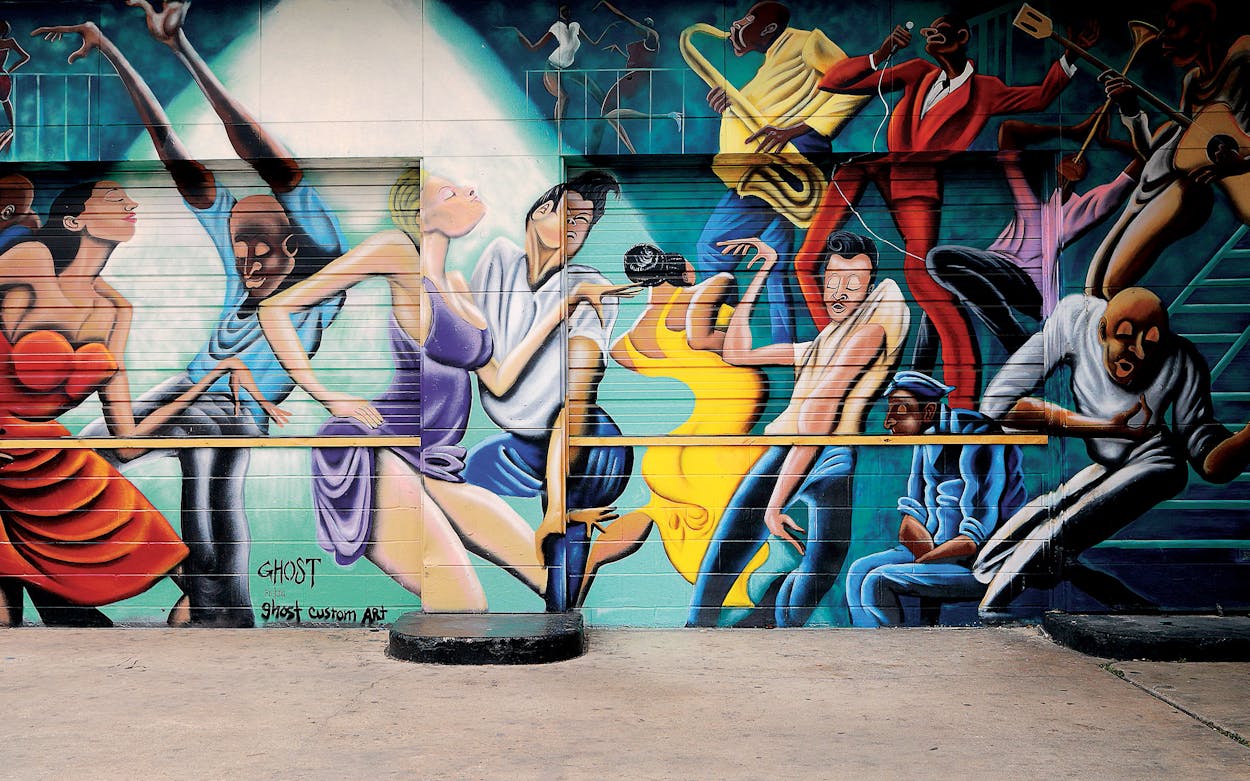On a wall at the corner of New Braunfels and Hays Streets, in San Antonio’s historically African American East Side, a bright mural depicts a bacchanal of Black, brown, and white folks dancing to a raucous jazz band. Everything is in motion: a red-suited singer wailing on the mic, the sax player and trumpeter trying hard to keep up, and the line of angular dancers seemingly poised to jump out of the painting. It’s an eye-catching scene that pays tribute to the multiracial music venues of San Antonio’s past, long-gone places such as the Eastwood Country Club and the Keyhole Club.
The mural, created in 2020 by Gerardo “Ghost” Cazares and inspired by Ernie Barnes’s iconic painting The Sugar Shack, is called The East Side Bar. It’s among the latest additions to San Antonio’s burgeoning palette of public art—murals, sculptures, and multimedia installations that are transforming streets and parks into outdoor galleries. In their elegant new book Arte del Pueblo: The Outdoor Art of San Antonio (Schiffer Publishing), former Texas poet laureate Carmen Tafolla and photographer Frederick R. Preston offer a panoramic view of these works, which collectively tell the stories of the people, culture, history, and natural setting that have made San Antonio one of the world’s most distinctive cities.
It wasn’t always this way. In the sixties and seventies, there was little public art of note to be found in San Antonio. The best known, of course, was the Alamo Cenotaph, a towering monolith dating to 1940 that is decked with sculpted figures of the Alamo’s martyrs, who “perished in the flames of immortality,” according to an inscription on its base. Some of the city’s denizens might also point to a panel of colorful painted tiles on a River Walk bridge that tells the story of a Mexican sniper who preyed on unsuspecting settlers who were giving their horses water at the banks of the San Antonio River. It is likely no coincidence that triumph over Mexican villainy is the theme of both works.


In the early eighties, though, inspired by the iconography and narratives of the Mexican American civil rights movement, Chicano artists painted murals on the walls of the Cassiano public housing project, in the historically Mexican American West Side. Drawing on the legacy of works by Mexican muralists such as David Alfaro Siqueiros, Diego Rivera, José Clemente Orozco, and Juan O’Gorman (whose vast mosaic mural Confluence of Civilizations in the Americas had debuted at San Antonio’s 1968 Hemisfair), the grassroots Community Cultural Arts Organization eventually recruited middle- and high-school students to create more than 125 murals that adorn schools, parks, and senior centers.
These affecting tableaux present stories from the Mexican community’s collective past: Cortés and his destruction of the Aztec world, leaders of Mexican insurgencies and revolutions, Mexican Americans’ service in the U.S. armed forces, the local community’s struggles with addiction, and the abiding presence of the Virgin of Guadalupe. The murals became akin to sacred texts of the community’s frequently disparaged heritage, a way to publicly display pride in its origins and the historical journeys of its ancestors.
In 1982 the city made a rare effort to enter the public art sphere when it approved a sculpture of the labor leader Samuel Gompers made from sandstone and oyster shells. (Gompers was not from San Antonio; his connection to the city was that he died there, soon after arriving by train.) The uniquely unappealing likeness, dedicated in a spot near the River Walk, depicted Gompers giving a speech while a throng of munchkin-size workers appeared to be clambering up around his legs from the proletarian depths. The backlash to this hideous sculpture may have left the city gun-shy about any further commissions. (The statue stayed around for decades but was removed three years ago, after significant deterioration.)

By the end of the eighties, small galleries, the Blue Star Contemporary, and an adjacent downtown arts complex had opened, and artists gathered to exchange ideas, works, and ambitions in multiethnic all-nighter salons like those at painter Franco Mondini-Ruiz’s Infinito Botánica. The design-
oriented verve that blossomed from these gatherings (think papel picado, Mexican trees of life, Gothic lettering, and plumbago) changed the city’s look and gestalt.
In the decades since, nonprofit organizations such as the Esperanza Peace and Justice Center, the Luminaria nighttime arts festival, MujerArtes, San Anto Cultural Arts, and SAY Sí trained, recruited, and commissioned artists to create new works across the city. A serious city-funded art push wouldn’t come along until 2011, when San Antonio’s Department of Arts & Culture created the Public Art Division, a program that has fostered hundreds of works. The successful initiative, which has been funded by revenue from the hotel occupancy tax, is regularly challenged during city council budget deliberations. Bexar County’s government, helmed by soon-to-retire judge Nelson Wolff, has been the lead supporter of the $180 million, 2.2-mile-long San Pedro Creek Culture Park, which provides space for new murals, sculptures, sound art, and engraved stone inscriptions (some of which I have contributed).
Many of the recent works of public art pictured in the book have quickly become an integral part of the city’s visual fabric, telling San Antonio’s stories to itself and the world. Xavier de Richemont’s 2014 The Saga is a twenty-minute-long digital projection on the facade of the San Fernando Cathedral that traces San Antonio’s history from its primordial origins to the present day. You can catch it in the evening on Tuesday, Friday, Saturday, and Sunday.
The city and county governments were, for decades, too slow to draw on and express their Latino majority’s aesthetic ambitions and treasured narratives. But they have, in recent years, begun to catch up. Margarita Cabrera’s expansive 2019 sculpture near Mission Espada, Árbol de la Vida: Memorias y Voces de la Tierra (“Tree of Life: Memories and Voices of the Land”), created by the artist in collaboration with public volunteers, is an adaptation of the traditional Mexican Tree of Life folk art form, hung with ornaments and historical figures from the city’s past.
All of these works show how you can “read” a city through its public art. Out of its deep Indigenous origins, San Antonio has become a city of the world. Its stories are told on walls, along trails, and at myriad intersections.
A common theme found in San Antonio’s public artworks is a fascination with the role water has played in the city’s economic and cultural development. Water was not only a resource for survival, but also central to stories of cultural exchange between the many peoples who have called the place home. Adriana Garcia’s sprawling 2018 tile mosaic mural in San Pedro Creek Culture Park, De Todos Caminos, Somos Uno (“From All Paths, We Are One”) evokes the epic of San Antonio’s history by interweaving her family’s story with the story of San Pedro Springs, where the city was founded.
In their introduction to Arte del Pueblo, Tafolla and Preston see the emergence of public art in San Antonio as part of the 300-year-old city’s path to knowing itself. Though San Antonio is a modern metropolis, it also boasts a rich natural setting with an Indigenous legacy stretching back 12,000 years. It is an international crossroads whose Spanish missions were recently designated a World Heritage Site.
“Art helps us understand who we are,” Tafolla and Preston write, “what we feel, and why we matter.” Driving or walking or biking through the city, one encounters works that evoke themes of struggle, resilience, and overcoming injustice. A vertical mural by Hailey Marmolejo painted on a building by Broadway and Interstate 35 features a monarch butterfly alighting on a maguey plant with a flowering stalk. An unfurling banner reads “Quisieron enterrarnos pero no sabían que eramos semillas” (“They wanted to bury us, but they didn’t know we were seeds”). In a traffic roundabout downtown, two great pillars of purple steel created by the Mexican artist Sebastián rise up as if some elemental earth energy has been unleashed and begun to take shape, like lightning bolts reaching, in reverse, toward the sky. This sculpture, Door of Equality, features the words “equality” and “igualdad” inscribed in large purple letters on a circular concrete plinth.
All of these works show how a pedestrian can “read” a city through
its public art—if art is given room to shine. Out of its deep Indigenous origins and its founding as an outpost of New Spain, San Antonio has become a city of the world. Its stories are told on walls, along trails, and at myriad intersections, by artists of familiar precincts and from well beyond.
This article originally appeared in the September 2022 issue of Texas Monthly with the headline “Brush With the Past.” Subscribe today.
- More About:
- Books
- Art
- San Antonio







